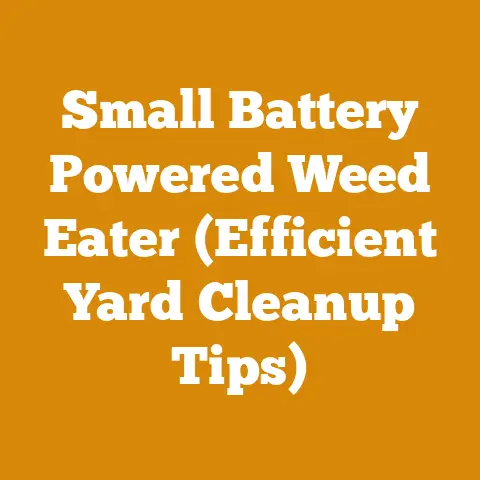Temp Wood Stove Tips (5 Expert Tricks to Cut Creosote Build-Up)
Imagine creosote as that unwelcome houseguest who overstays their welcome, slowly but surely turning your cozy wood stove into a potential hazard. It’s the uninvited byproduct of burning wood, clinging to your chimney like a persistent shadow. But fear not, fellow wood-burning enthusiasts! I’m here to share some expert tricks I’ve learned over the years to help you keep that creosote build-up at bay and ensure your wood stove burns safely and efficiently. I’ve been around wood stoves my entire life, from helping my grandfather stack firewood as a kid to now heating my own home entirely with wood. I’ve seen firsthand the dangers of neglecting creosote and the peace of mind that comes with proper wood stove maintenance. These aren’t just theoretical tips; they’re hard-earned lessons from years of experience.
Taming the Creosote Beast: Expert Wood Stove Tips
Creosote is a real concern for anyone who heats with wood. It’s a flammable residue that accumulates in your chimney and stovepipe, and if enough builds up, it can cause a chimney fire. Nobody wants that! My goal here is to give you the knowledge and tools to minimize creosote formation and keep your home safe and warm.
Understanding Creosote Formation: The Root of the Problem
Before we dive into the solutions, it’s crucial to understand how creosote forms in the first place. Creosote is formed when unburned wood particles and gases cool and condense in the chimney. Several factors contribute to this process:
- Burning Unseasoned Wood: This is the biggest culprit. Wet wood requires more energy to burn, which lowers the fire’s temperature and increases the amount of unburned gases and moisture released.
- Low Fire Temperature: A smoldering fire doesn’t burn efficiently. The lower temperature allows more unburned particles to escape into the chimney.
- Restricted Airflow: Insufficient air leads to incomplete combustion, resulting in more smoke and creosote.
- Cold Chimney Temperatures: A cold chimney allows the gases to cool more quickly, encouraging condensation and creosote build-up.
Think of it like this: imagine trying to bake a cake in an oven that isn’t hot enough. The cake might eventually “cook,” but it’ll be dense, gummy, and not very appealing. Similarly, a low-temperature fire won’t fully combust the wood, leaving behind a messy residue – creosote.
Trick #1: Season Your Wood Like a Pro
Seasoning, or drying, your firewood is the single most impactful thing you can do to reduce creosote. Freshly cut wood can contain upwards of 50% moisture content. Properly seasoned wood should have a moisture content below 20%. Burning wood with high moisture content leads to incomplete combustion, resulting in more smoke, creosote, and less heat.
How to Season Wood Effectively:
- Split it First: Splitting wood exposes more surface area, allowing moisture to evaporate more quickly.
- Stack it Right: Elevate the wood off the ground using pallets or scrap wood. This allows air to circulate underneath. Stack the wood in rows with gaps between them to promote airflow. A simple “holzhaufen” (a circular wood stack) can be aesthetically pleasing and functional.
- Sun and Wind Exposure: Choose a location that receives plenty of sunlight and wind. This will accelerate the drying process.
- Cover the Top, Not the Sides: Cover the top of the woodpile to protect it from rain and snow. However, leave the sides open to allow for ventilation.
- The Two-Year Rule (and Beyond): Ideally, hardwoods like oak and maple should be seasoned for at least two years. Softwoods like pine can season in as little as six months, but I still prefer a year for optimal results.
My Personal Experience:
I once made the mistake of burning wood that I thought was seasoned, but clearly wasn’t. The fire was sluggish, produced a lot of smoke, and I noticed a significant increase in creosote build-up in my chimney. Lesson learned! Now, I always use a moisture meter to check the moisture content of my wood before burning it. It’s a worthwhile investment, saving you headaches and ensuring a safer, more efficient burn. A good moisture meter can be had for around $30 and pays for itself quickly in improved efficiency and reduced creosote.
Data Point: Studies have shown that burning seasoned wood can reduce creosote build-up by as much as 50% compared to burning unseasoned wood. This translates to less frequent chimney cleanings and a reduced risk of chimney fires.
Trick #2: Hot Fires are Happy Fires (and Cleaner Ones!)
Burning your wood stove at a higher temperature is another crucial factor in reducing creosote. A hot fire promotes complete combustion, burning off more of the volatile gases and particles that contribute to creosote formation.
How to Achieve a Hotter Fire:
- Use Smaller Pieces of Wood: Smaller pieces of wood ignite more quickly and burn more efficiently.
- Control Airflow: Don’t starve the fire of oxygen. Adjust the air controls on your stove to allow for sufficient airflow.
- Don’t Overload the Stove: Overloading the stove can smother the fire and reduce its temperature.
- Burn “Hot” Woods Occasionally: Occasionally burning a few pieces of faster-burning wood, like birch, can help increase the fire’s temperature and burn off any existing creosote. Be careful to not overfire your stove!
A Word of Caution:
While hotter fires are generally better, it’s important to avoid overfiring your stove. Overfiring can damage the stove and chimney and create a fire hazard. Always follow the manufacturer’s recommendations for safe operating temperatures.
My Personal Experience:
I used to be afraid of burning my stove too hot, so I’d often keep the air controls turned down low. This resulted in a smoldering fire that produced a lot of smoke and creosote. Once I learned about the importance of a hot fire, I adjusted my burning habits and saw a significant reduction in creosote build-up.
Data Point: A study by the Chimney Safety Institute of America (CSIA) found that burning wood at a higher temperature can reduce creosote formation by up to 75%.
Trick #3: Airflow is Your Friend
Proper airflow is essential for efficient combustion and reducing creosote. Insufficient airflow leads to incomplete burning, resulting in more smoke and creosote.
How to Optimize Airflow:
- Clean Your Chimney Regularly: A clogged chimney restricts airflow and increases the risk of creosote build-up. I recommend having your chimney inspected and cleaned at least once a year, or more often if you burn wood frequently.
- Use a Chimney Cap: A chimney cap prevents debris from entering the chimney and restricting airflow.
- Ensure Proper Ventilation in Your Home: Make sure your home has adequate ventilation to allow for proper airflow to the stove.
- Check for Obstructions: Regularly inspect your chimney and stovepipe for any obstructions, such as bird nests or debris.
My Personal Experience:
I once had a bird build a nest in my chimney, completely blocking the airflow. The stove was smoking badly, and I quickly realized something was wrong. After removing the nest, the stove burned much more efficiently, and the smoke was significantly reduced.
Data Point: The National Fire Protection Association (NFPA) recommends that chimneys be inspected and cleaned at least once a year by a qualified professional.
Trick #4: The Top-Down Burn Method
This burning method, also known as the “upside-down” method, involves loading your wood stove with the largest logs on the bottom and the kindling and smaller pieces on top. This creates a top-down fire that burns more cleanly and efficiently.
How to Execute the Top-Down Burn:
- Load the Stove: Place the largest logs on the bottom of the stove, arranged tightly together.
- Add Smaller Pieces: Place smaller pieces of wood on top of the larger logs, creating a layer of kindling.
- Top it Off: Add a layer of tinder, such as paper or small twigs, on top of the kindling.
- Light the Fire: Light the tinder at the top of the pile.
Why it Works:
The top-down burn method creates a hotter, cleaner fire by burning the volatile gases at the top of the pile before they can escape into the chimney. This reduces creosote formation and increases the efficiency of the burn.
My Personal Experience:
I was initially skeptical of the top-down burn method, but after trying it, I was amazed at how well it worked. The fire burned much more cleanly, and I noticed a significant reduction in smoke. It’s now my go-to method for starting a fire in my wood stove.
Data Point: Studies have shown that the top-down burn method can reduce particulate emissions by up to 50% compared to traditional bottom-up burning methods. This translates to less smoke, less creosote, and a healthier environment.
Trick #5: Regular Chimney Inspections and Cleaning
Even with the best practices, some creosote build-up is inevitable. Regular chimney inspections and cleaning are essential for preventing chimney fires and ensuring the safe operation of your wood stove.
Frequency of Inspections and Cleaning:
- At Least Once a Year: I recommend having your chimney inspected and cleaned at least once a year, preferably in the spring or summer after the heating season.
- More Often if Needed: If you burn wood frequently, or if you notice signs of creosote build-up, such as a smoky smell or reduced draft, you may need to have your chimney cleaned more often.
Signs of Creosote Build-Up:
- Smoky Smell: A persistent smoky smell in your home, even when the stove is not in use, can be a sign of creosote build-up.
- Reduced Draft: A reduced draft in your chimney can indicate that the flue is partially blocked by creosote.
- Black, Flaky Deposits: If you see black, flaky deposits around the chimney cap or stovepipe, it’s a sign of creosote build-up.
- A Shiny, Glazed Appearance: Third-degree creosote, the most dangerous type, has a shiny, glazed appearance.
DIY vs. Professional Cleaning:
You can clean your chimney yourself using a chimney brush and extension rods. However, I recommend hiring a professional chimney sweep for the first cleaning, as they have the experience and equipment to do the job safely and effectively. They can also identify any potential problems with your chimney.
My Personal Experience:
I once neglected to have my chimney cleaned for several years, and I ended up with a significant creosote build-up. It was a scary experience, and I learned my lesson. Now, I make sure to have my chimney inspected and cleaned every year without fail.
Data Point: According to the CSIA, chimney fires are a leading cause of home fires in the United States. Regular chimney inspections and cleaning are essential for preventing these fires.
Beyond the Basics: Advanced Strategies for Creosote Control
While the five tricks above are fundamental, here are some additional strategies I’ve picked up over the years that can further enhance your creosote control efforts.
Wood Species Selection: Not All Wood is Created Equal
Different types of wood burn differently and produce varying amounts of creosote. Hardwoods, like oak, maple, and ash, generally burn hotter and cleaner than softwoods, like pine and fir. Softwoods contain more resin, which can contribute to creosote formation.
My Recommendation:
I prefer to burn hardwoods whenever possible. They provide more heat and produce less creosote. However, softwoods can be useful for starting fires or for quick bursts of heat. If you do burn softwoods, make sure they are well-seasoned and burn them hot.
Data Point: Hardwoods typically have a higher BTU (British Thermal Unit) content than softwoods, meaning they produce more heat per unit of volume.
Proper Stovepipe Installation: A Crucial Detail
The way your stovepipe is installed can significantly impact creosote build-up. A properly installed stovepipe should have a slight upward slope (at least 1/4 inch per foot) to allow for proper draft. It should also be made of heavy-gauge steel and have airtight connections.
Common Mistakes:
- Insufficient Slope: A stovepipe that is too flat or slopes downward can trap creosote and restrict airflow.
- Loose Connections: Loose connections can allow smoke and gases to escape into your home.
- Using the Wrong Type of Stovepipe: Single-wall stovepipe is not suitable for use as a chimney. It should only be used to connect the stove to the chimney.
My Recommendation:
If you are not comfortable installing your stovepipe yourself, hire a qualified professional to do it for you. It’s worth the investment to ensure that it’s done correctly.
Data Point: Improper stovepipe installation is a common cause of chimney fires.
The Importance of a Clean-Burning Stove
Modern wood stoves are designed to burn more cleanly and efficiently than older models. They often feature technologies like catalytic combustors or secondary combustion systems that burn off more of the volatile gases and particles that contribute to creosote formation.
Benefits of a Clean-Burning Stove:
- Reduced Creosote: Clean-burning stoves produce significantly less creosote than older models.
- Increased Efficiency: They burn wood more efficiently, providing more heat with less fuel.
- Lower Emissions: They produce fewer emissions, making them more environmentally friendly.
My Recommendation:
If you are considering purchasing a new wood stove, look for a model that is EPA-certified. EPA-certified stoves meet strict emission standards and are more efficient and cleaner burning.
Data Point: EPA-certified wood stoves can reduce particulate emissions by up to 70% compared to older, non-certified models.
Strategic Fire Management: A Holistic Approach
Ultimately, managing creosote is about more than just following individual tips; it’s about adopting a holistic approach to fire management. This involves understanding the factors that contribute to creosote formation and making informed decisions about wood selection, burning practices, and stove maintenance.
Key Takeaways:
- Prioritize Seasoned Wood: This is the most important factor in reducing creosote.
- Burn Hot Fires: A hot fire promotes complete combustion and reduces creosote formation.
- Optimize Airflow: Ensure proper airflow to your stove and chimney.
- Use the Top-Down Burn Method: This method can reduce particulate emissions and creosote build-up.
- Regularly Inspect and Clean Your Chimney: This is essential for preventing chimney fires.
- Choose the Right Wood: Hardwoods are generally better than softwoods.
- Install Your Stovepipe Properly: A properly installed stovepipe is crucial for safe and efficient operation.
- Consider a Clean-Burning Stove: Modern wood stoves are designed to burn more cleanly and efficiently.
My Final Thoughts: A Lifetime of Learning
Heating with wood is a rewarding experience, but it requires knowledge, diligence, and a commitment to safety. I’ve shared with you the tricks and strategies that I’ve learned over a lifetime of burning wood. I hope these tips will help you keep your wood stove burning safely and efficiently for many years to come. Remember, creosote is a persistent adversary, but with the right knowledge and practices, you can keep it at bay and enjoy the warmth and comfort of a wood-burning fire without worry.
Next Steps:
- Assess Your Current Practices: Evaluate your current wood-burning practices and identify areas for improvement.
- Implement the Tips: Start implementing the tips and strategies outlined in this article.
- Monitor Your Results: Keep track of your progress and adjust your practices as needed.
- Stay Informed: Continue to learn about wood-burning best practices and stay up-to-date on the latest safety recommendations.
- Enjoy the Warmth! With a little effort and attention to detail, you can enjoy the warmth and comfort of a wood-burning fire safely and efficiently.
Now go forth, tend to your fires wisely, and may your home be warm and your chimney creosote-free!






